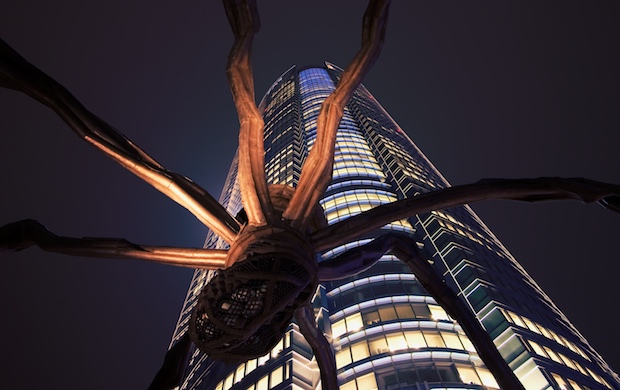Maman - Louise Bougeois, Tokyo, photo: Owen Schaefer
Within scant hours of Louise Bourgeois’ death this Monday (Tuesday for those of us in Tokyo) her name was trending in Twitter, her entry in Wikipedia had been updated and all the major papers had run articles. I say this not to hype the wonders of technology, but to point out that few artists could expect such a passionate and popular eulogy.
I came to Bourgeois late. I have never seen a retrospective. Never seen any of her works outside of photos, aside from the infamous Maman, and I’m the sadder for it. Tokyo’s bronze-cast version of this enormous spider stands unfortunately close to Roppongi’s Mori Tower — Maman, I feel, should stand alone to dwarf her viewers, not be diminished herself by architecture. But still, the sculpture captivates, and its many versions have reached viewers from the most critical to the most casual.
And so maybe Maman is enough.
Maman towers over us; she invites that delicious mixture of horror and fascination; speaks to our deepest revulsions, makes them beautiful, and then threatens us with them. Reactions are so often the same in the shade of her eight legs — first the giggling novelty, then the admiration, and finally the inevitable gasp at noticing the white marble eggs hanging in her belly, and silence as the whole sculpture reforms itself in the shocked viewer’s consciousness, moving from creature-feature amusement to something else — something protective, procreative, and unexpectedly, powerfully feminine.
Maman makes us small and soft. Maman makes us afraid. Maman fills us with awe. And most of all Maman has multiplied; her eggs hatching, it seems, spiders scuttling from New York to London to Bilbao to St. Petersburg to Paris to Cuba, to Boston, Ottawa, Kansas City and Seoul. Maman, like our own mothers, always seems near.
And while this spider may be the grace, power and fear of motherhood (and let us not forget how many male spiders become a meal for their mates) then Bourgeois also gave birth to something larger than just symbolism. She turned all of our preconceptions inside out, and refused to tell us it was going to be all right. And most of all, I like to think that in creating Maman, she became mother and daughter at once: creator and child together. Bourgeois became her own conceptual grandmother, reinventing herself over and over, and lived to be 98 years old in process. It seemed like she would go on forever.
And in the memories of many, many people, she will.









